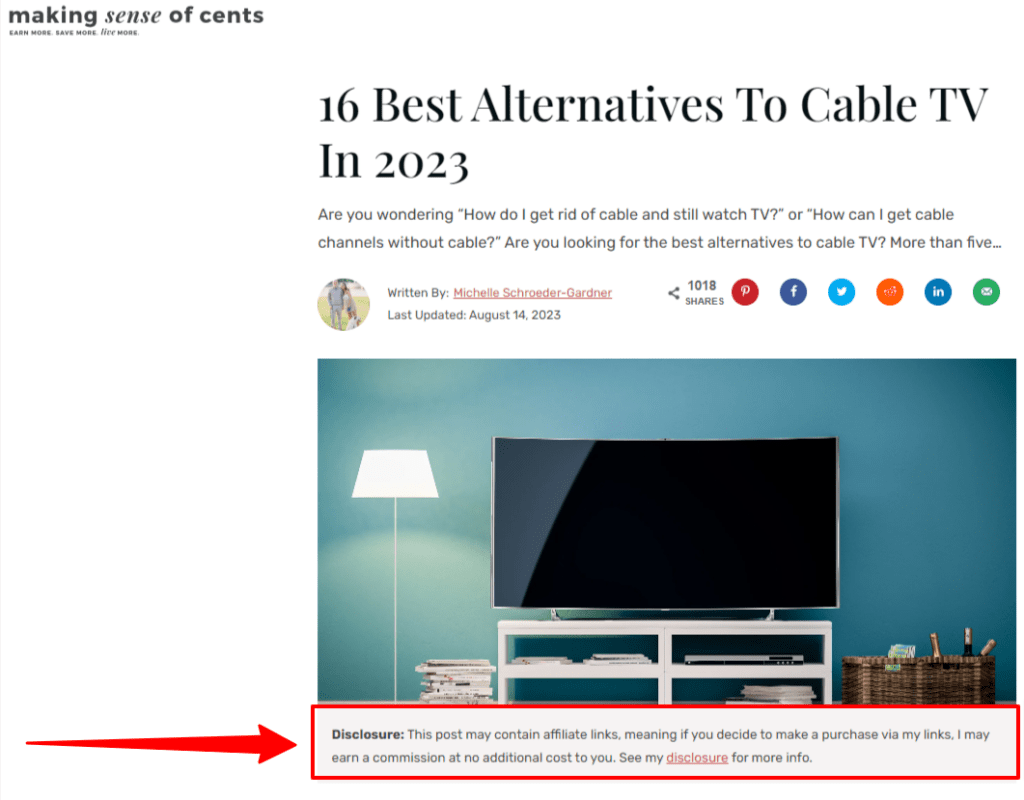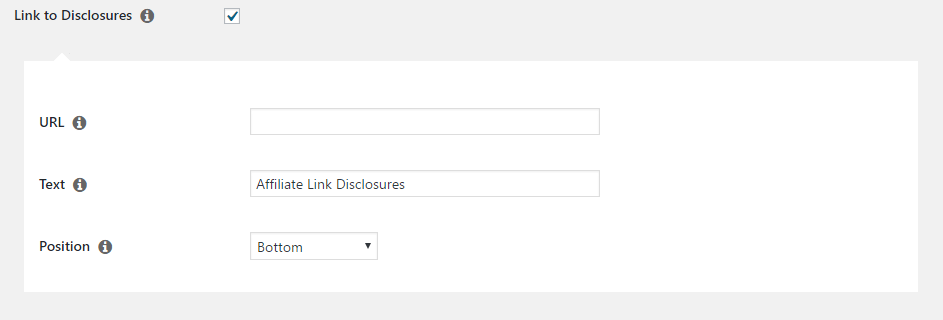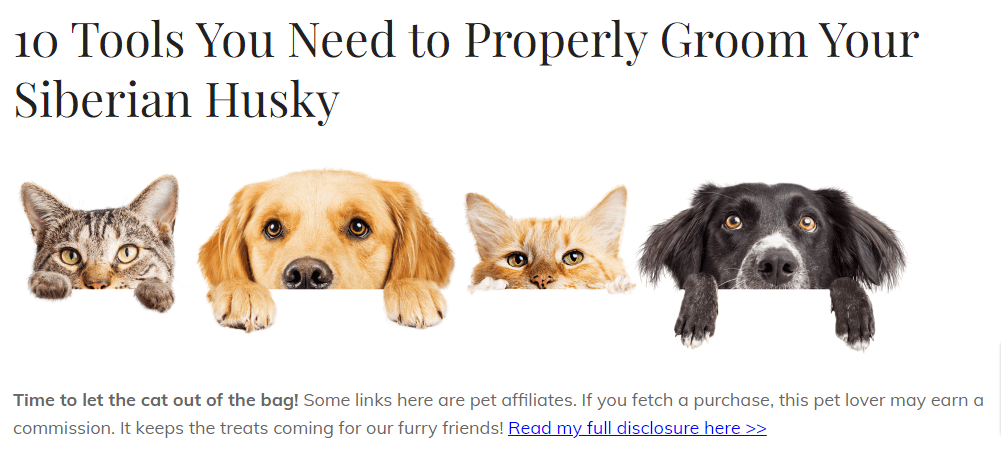Contents
It’s no secret that links are the backbone of affiliate marketing. But here’s the thing: recklessly dropping paid links all over your website without giving it a second thought can land you in some serious legal muddles.

That’s where link disclosures come into play. These nifty little notes are key to linking responsibly, ensuring you stay in the good books of the law; and more importantly, keeping things transparent and trustworthy between you and your audience.
In this article, we’re going to unpack everything you need to know about affiliate link disclosures. We’ll start by explaining what they are and why they’re important. Next, we’ll share 5 best practices related to disclosure writing and even how to go about positioning them on your site automatically with PrettyLinks!
Ready to get the lowdown? Let’s jump in!
What’s the Deal with Affiliate Link Disclosures? (and Why Do You Need Them?)
Affiliate link disclosures are more than a best practice; they’re a must-do according to the Federal Trade Commission (FTC). What it boils down to is, if you have a link on your site that could potentially earn you some cash, you need to be upfront about it with your visitors.
This isn’t restricted to just affiliate links either; it covers endorsements, sponsorships, and similar arrangements.
Now, you might be thinking, “Why the extra step?” Well, here are a couple of compelling reasons:
- Promoting Fair Business Practices: Disclosures level the playing field for all marketers. They ensure that everyone plays by the same rules, allowing consumers to make informed decisions and choose to buy from marketers they genuinely trust.
- Building Trust with Your Audience: Transparency is the cornerstone of trust. By being upfront about your affiliations, you’re showing readers that you have nothing to hide. This openness can foster a stronger bond between you and your audience.
While it might seem like an added task, disclosures aren’t there to make life difficult for marketers. Think of them as a bridge of trust between you and your readers, benefiting both parties in the long run.
5 Best Practices for Affiliate Link Disclosures
Affiliate link disclosures are fairly easy to implement, but there are several different ways to maximize their effectiveness. Let’s take a look at 5 practices that are FTC-compliant.
1. Disclosure Dilemma: To Tell or Not to Tell
When you’re unsure about whether to include an affiliate link disclosure, it’s usually a smart move to go on ahead and disclose. Here’s why:
- Legal Compliance: Again, you want to make sure you’re following the law. Many places, including the United States, have regulations that mandate informing your audience about your affiliations with the brands you’re promoting. Ignoring these rules could lead to fines and legal hassles.
- Audience Trust: As we stress repetitively throughout this article, establishing trust with your audience is a big deal in affiliate marketing. When you’re open about using affiliate links, it shows you’re honest and upfront. You’re not just trying to make a quick buck; you genuinely believe in the products you’re promoting. This trust can lead to long-term success and a loyal following.
- Platform Policies: Different online platforms, such as social media and specific affiliate programs, may have their own rules about disclosures. Failing to adhere to these rules could land you in hot water or even result in your removal from the platform.
- Ethical Considerations: Even if it’s not a legal requirement, consider the ethics of the situation. Put yourself in your audience’s shoes. Would you appreciate it if others were honest about their affiliations? Ethical affiliate marketing goes a long way in maintaining a positive reputation.
Go ahead and make it a habit to disclose whenever necessary, ensuring you’re transparent about your affiliations from the start.
2. Smart Disclosure Placement Strategies
Disclosures are an easy means of revealing your affiliate partnerships and making sure your audience is aware of third-party involvements. However, where and how you place them on your website can also influence the level of trust you cultivate with your readers.
Here’s a great example of someone who knows how to put disclosures right where everyone can see them:

Michelle of Making Sense of Cents keeps it simple by putting her disclosures right at the start of her blog posts. This way, they’re impossible to miss and shows her readers right from the get-go that she’s all about being open and honest.
To nail this practice, consider these 2 pointers for positioning disclosures on your website or blog:
- Start your blog posts with a disclosure: Put a clear and straightforward disclosure right at the beginning of your content. This way, anyone who’s not into affiliate links can make up their mind right away. Plus, it protects you from any accusations of being sneaky. Starting with transparency sets the right tone for your content.
- Make your disclosure visible near affiliate links: You don’t have to interrupt the flow of your writing for this. Just use a simple symbol or asterisk next to the affiliate link and place the disclosure at the end of your article. It’s like a little heads-up for your readers, letting them know what’s what without messing up their reading experience.
The main thing to remember is, you shouldn’t hide your disclosures in some dark corner of your site. When you do that, it can seem like you’re only doing it because you have to, not because you want to be open with your readers.
3. The Crucial Role of Consistency in Affiliate Disclosures
The FTC emphasizes the importance of making your affiliations clear and conspicuous. This means you must be consistent in where you place your disclosures, how you phrase them, and how visible they are.
When your audience can predict where and how your disclosures will appear, it creates a sense of reliability.
Imagine reading a blog where the disclosure placement and wording change with every post. It can be confusing and disrupt your trust.

But when you maintain a standard format, your readers know what to expect, and transparency becomes second nature.
With a standard disclosure format in place, you also dramatically reduce the chances of making errors or accidentally overlooking a required disclosure as well. Consider it a streamlined routine that keeps you on the right path.
4. Create a Dedicated Disclosure Page
Having an affiliate disclosure page helps ensure that transparency remains a top priority, while also offering visitors a comprehensive peek into your affiliate connections.
One big perk of having a dedicated disclosure page is the convenience it brings. It acts as a central hub, effortlessly guiding your audience to the crucial information about your affiliations and partnerships
You’re essentially simplifying the process of presenting and obtaining vital information. It’s like handing your audience a well-drawn roadmap, simplifying their journey through your affiliations and ensuring they have access to the transparency they deserve.
5. Write a Disclosure that Resonates with Your Audience
Lastly, readers don’t want to wade through robotic jargon when they read your affiliate disclosures. They’re here for your unique voice, and it’s essential to make your affiliate disclosures feel as authentic as the rest of your content.
Here’s a few tips to bring more of your brand’s voice into an otherwise boring disclosure message:
- Be Direct, But Be You: Ditch the formalities. Instead of saying, “I may receive compensation for the links on this page,” try something like, “Hey, if you buy something through my links, I might get a little something-something as a thank you. No extra cost to you, promise!”
- Use Everyday Lingo: Words like “commission” are cool, but feel free to mix it up. “I get a little thank you bonus if you shop through my links” is casual and gets the point across.
- Dodge the Jargon: Not everyone knows what “pay-per-click” means, and that’s okay. If you do drop some industry terms, give a quick lowdown. Like, “Affiliate links (links that give me a small reward if you buy) are sprinkled in this post.”
- Add Your Brand’s Flavor: Your brand has its own vibe; let it shine in your disclosure. If you’re all about humor, make it light-hearted. If you’re about empowerment, make it uplifting. For instance, a fitness blogger might say, “Every time you buy through my links, you’re not just getting awesome gear; you’re also giving me a little high-five in commission form. Thanks for the love and support!”
Remember, the goal is to be transparent but in a way that feels true to you and your brand. It’s all about building trust while keeping things real and relatable.
How PrettyLinks Can Help You Disclose Your Affiliate Links Automatically
If you’re looking for an easy way to handle affiliate disclosures on your blog, PrettyLinks has your back!
All you need is a dedicated disclosure page (something like what we talked about earlier) and the PrettyLinks Keyword Replacement tool. This setup will automatically insert disclosure notices within your content and across your site in seconds!
Step 1: Enable Link to Disclosures
Go to PrettyLinks in your WordPress dashboard and head to “Options.” If you haven’t already enabled “Replacements,” do that first. Then, toggle on “Link to Disclosures”:

Step 2: Define Your Disclosure URL
In the “URL” box, drop in the web address of your dedicated affiliate disclosure page.
Step 3: Craft Your Link Text
In the “Text” section, here’s where you’ll type in the text you want visitors to see when the disclosure link works its magic.
Step 4: Pick a Perfect Position
Where do you want your disclosure link to appear? PrettyLinks gives you options. You can have it greet your readers at the top of your content, chill out at the bottom, or be a friendly presence in both places. It’s your call.
Step 5: Save Your Settings
After setting things up the way you like, don’t forget to hit the “Update” button at the bottom of the page. It’s like sealing the deal on your new and improved affiliate disclosure setup.
Here’s what your automatically linked disclosure might look like:

Conclusion
Affiliate link disclosures are a legal necessity, but their use can also build reader trust in both you and your affiliate products. With a link management tool such as PrettyLinks, you can create affiliate disclosures for your website in seconds, and you can even automate the process.
In the above post, we provided you with 5 affiliate disclosure best practices. To recap:
- When in doubt, always disclose.
- Prioritize the placement of your disclosures.
- Maintain consistency in your messaging.
- Consider having a dedicated disclosure page.
- Personalize your disclosures in your unique tone.
Do you have any questions about affiliate link disclosures or how to set them up with PrettyLinks? Let us know in the comments section below!
If you liked this article, be sure to follow us on Facebook, Twitter, Pinterest, and LinkedIn! And don’t forget to subscribe to our newsletter.








Leave a Reply